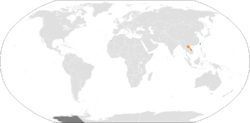China–Laos relations
This article needs to be updated. (November 2010) |
This article needs editing for compliance with Wikipedia's Manual of Style. (July 2020) |
 | |
China |
Laos |
|---|---|
 | |
Taiwan |
Laos |
|---|---|
Laotian–Chinese relations (Lao: ສາຍພົວພັນ ລາວ-ຈີນ, Chinese: 中老关系/中寮關係) refers to the current and historical relationship between Lao People's Democratic Republic and the People's Republic of China (Red China). Relations between the two states were established in 1953 with the Republic of China (Nationalist China or Taiwan) as the sole legitimate government of China. On 25 April 1961, Laos switched recognition to the PRC government in Beijing.[1] However on 16 May 1962, the royal government severed diplomatic relations with Red China and restored relations with the Taipei government, aligning with the anti-communist alliance in the Vietnam War until 1975 when the new Lao communist government re-established relations with the PRC.[2] Laos is represented by the Taipei Economic and Cultural Representative Office in Hanoi for ROC-related matters.
Relations have consisted of trade and aid, largely focused on road construction in the northern provinces of Laos, without directly challenging the interests of Thailand or Vietnam in the central and southern regions. However, Vietnam's invasion of Cambodia in December 1978 to unseat the Khmer Rouge regime provoked China into a limited invasion of Vietnam—approximately nineteen kilometers deep—to "teach Vietnam a lesson." Laos was caught in a dangerous bind, not wanting to further provoke China, but not able to oppose its special partner, Vietnam. The Laotian leadership survived the dilemma by making slightly delayed pronouncements in support of Vietnam after some intraparty debate and by sharply reducing diplomatic relations with China to the chargé d'affaires level—without a full break. The low point in Sino-Laotian relations came in 1979, with reports of Chinese assistance and training of Hmong resistance forces under General Vang Pao in China's Yunnan Province.[3]
This hostile relationship gradually softened, however, and in 1989 Prime Minister Kaysone Phomvihane paid a state visit to Beijing. In 1991 Kaysone chose to spend his vacation in China rather than make his customary visit to the Soviet Union. Diplomatic and party-to-party relations were normalized in 1989. Trade expanded from the local sale of consumer goods to the granting of eleven investment licenses in 1991—including an automotive assembly plant. Following the establishment of the Laotian-Chinese Joint Border Committee in 1991, meetings held during 1992 resulted in an agreement delineating their common border. China's commercial investments and trade with Laos expanded quietly, but not dramatically, in 1993 and 1994.[3] CCP general secretary Xi Jinping held talks with LPRP general secretary Bounnhang Vorachit in 2016, seeking further coordination in international affairs.[4]
In June 2020, Laos was one of 53 countries that backed the Hong Kong national security law at the United Nations.[5]
See also[]
Bibliography[]
- Cardenal, Juan Pablo; Araújo, Heriberto (2011). La silenciosa conquista china (in Spanish). Barcelona: Crítica. pp. 183–186, 230–232. ISBN 9788498922578.
References[]
- ^ China (Taiwan), Ministry of Foreign Affairs, Republic of (1962-11-01). "Overseas Chinese". Taiwan Today. Retrieved 2021-04-23.
- ^ China (Taiwan), Ministry of Foreign Affairs, Republic of (1966-01-01). "The Month in Free China". Taiwan Today. Retrieved 2021-04-23.
- ^ Jump up to: a b Brown, MacAlister and Joseph J. Zasloff. "Relations with China". Laos: a country study (Andrea Matles Savada, editor). Library of Congress Federal Research Division (July 1994). This article incorporates text from this source, which is in the public domain.
- ^ "China's Xi holds talks with Lao leader to enhance ties". Xinhua. Xinhua News Agency. May 3, 2016. Retrieved 4 May 2016.
- ^ Lawler, Dave (2 July 2020). "The 53 countries supporting China's crackdown on Hong Kong". Axios. Retrieved 3 July 2020.
- China–Laos relations
- Bilateral relations of China
- Bilateral relations of Laos
- Economy of Yunnan

